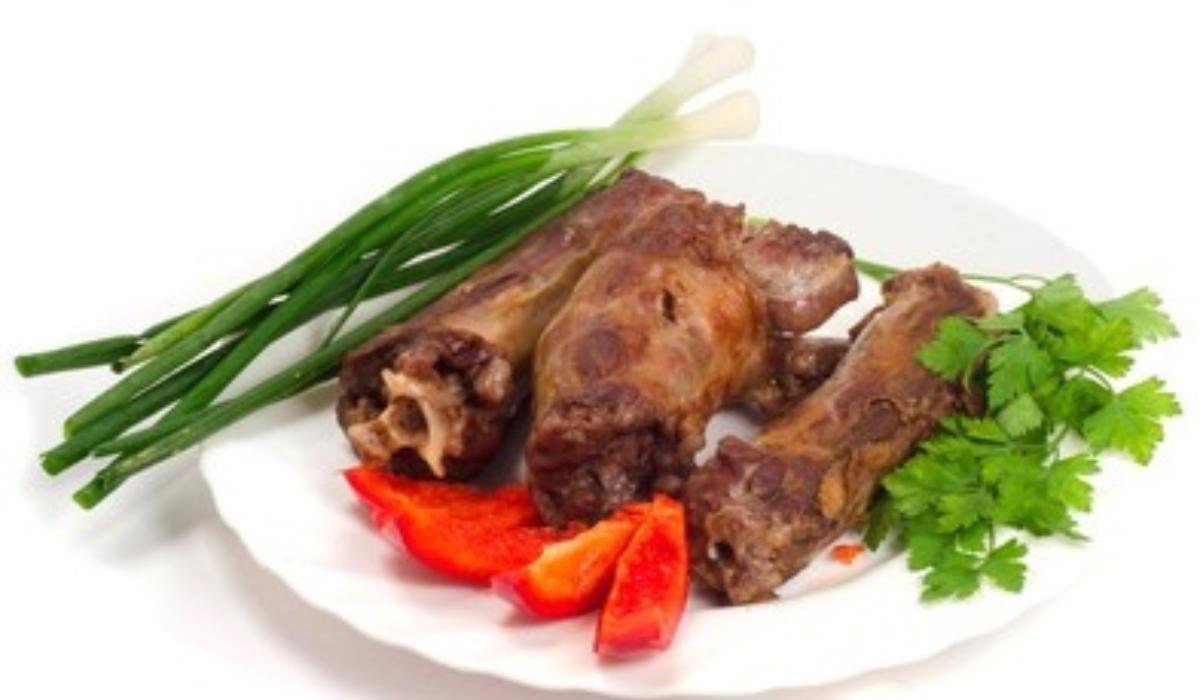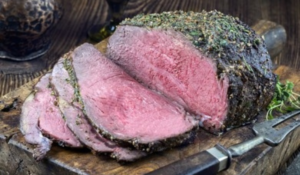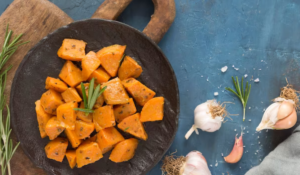Sharing is caring!
Table of Contents
ToggleIntroduction: Mastering the Art of Cooking Turkey Necks
Welcome to the flavorful journey of learning how to cook turkey necks, a dish that often flies under the radar yet holds immense culinary potential. Turkey necks, with their rich texture and robust flavor, present a delightful challenge to both novice and seasoned cooks. This guide is designed to demystify the process, offering you the keys to transform this underrated cut into a delectable feast.
As we delve into the nuances of cooking turkey necks, you’ll discover the versatility of this ingredient. Whether slow-cooked to tender perfection, roasted to achieve a crispy exterior, or simmered in savory broths, turkey necks can adapt to various cooking styles. They are not just a treat for the taste buds but also a healthier alternative, packed with nutrients and protein.
Our journey will guide you through selecting the best quality turkey necks, understanding the importance of preparation, and exploring a spectrum of cooking methods and flavor combinations. We aim to equip you with the skills and knowledge to confidently cook turkey necks, ensuring a delicious outcome every time.
So, let’s embark on this culinary adventure together, and unlock the secrets of how to cook turkey necks in a way that will leave your guests craving for more.For more tips on selecting quality meats, check out The Butcher’s Guide.
Choosing the Right Turkey Necks for Your Dish
The secret to a mouth-watering dish starts with selecting the best ingredients. When it comes to mastering how to cook turkey necks, choosing the right ones is crucial. Turkey necks vary widely in quality and flavor, and your choice can significantly impact the final dish.
First, consider the source of your turkey necks. Opt for fresh, locally sourced necks if available. Fresh turkey necks are more likely to retain their natural juices and flavors, essential for a succulent dish. However, if fresh isn’t an option, frozen turkey necks can be a convenient alternative. Just ensure they are properly thawed before cooking to maintain texture and taste.
Organic and free-range turkey necks are also worth considering. These usually come from turkeys that have been raised without antibiotics and have had a natural diet. This not only contributes to a more ethical choice but often results in better flavor and texture.
When inspecting turkey necks, look for ones with a firm texture and a healthy color. They should be pinkish and free from any unpleasant odors. Size also matters – larger necks will take longer to cook but can provide more meat, making them ideal for heartier dishes.
Remember, the right turkey necks are the foundation of your dish. Your choice influences not just the flavor but also the cooking time and technique. By selecting high-quality turkey necks, you set the stage for a culinary experience that will impress anyone who tastes your creation. So, take your time, choose wisely, and you’re well on your way to perfecting how to cook turkey necks.
Preparation Basics: Setting the Stage for Cooking Turkey Necks
Before you dive into the process of how to cook turkey necks, proper preparation is key. It ensures your dish is not only delicious but safe to eat. Here’s a straightforward guide to get your turkey necks ready for the culinary spotlight.
Start by rinsing your turkey necks under cold water. This step removes any residual blood or fragments from packaging, ensuring a clean start. Once rinsed, pat them dry with paper towels. Dry turkey necks brown better and absorb seasonings more effectively, leading to a richer flavor profile.
Next, trimming is essential. Trim off any excess fat to prevent your dish from becoming too greasy. However, remember to leave some fat on for flavor. This balance is vital for achieving that perfect succulence in your final dish.
Seasoning plays a pivotal role in how to cook turkey necks. This is where you can get creative. A simple sprinkle of salt and pepper is a classic choice, but don’t hesitate to explore. Incorporate herbs like thyme or rosemary for an aromatic touch, or add a bit of heat with cayenne pepper or paprika. For deeper flavors, consider marinating the necks in a blend of your favorite spices and herbs.
Finally, let your turkey necks reach room temperature before cooking. This step ensures even cooking, preventing the outside from overcooking while the inside remains underdone.
Proper preparation sets the tone for your entire cooking process. By taking these simple yet effective steps, you create the perfect canvas for your culinary skills to shine. With your turkey necks prepped and ready, you’re all set to explore the various delicious ways of how to cook turkey necks.
Cooking Methods: Exploring the Best Ways to Cook Turkey Necks
When you’re learning how to cook turkey necks, it’s essential to explore various cooking methods to find the one that suits your taste. Each method brings out different flavors and textures, making turkey necks a versatile ingredient for any meal.
Slow Cooking: Slow cooking is ideal for turning turkey necks into a tender, fall-off-the-bone delight. This method allows the necks to absorb flavors over several hours, resulting in a rich and deep taste. Simply place the necks in a slow cooker with your choice of broth, vegetables, and seasonings. Let them cook on low heat for 6-8 hours or until they are tender. The slow cooker does the magic, infusing the necks with moisture and flavor.
Roasting: Roasting is perfect for those who prefer a crispy outer layer. Preheat your oven, season the turkey necks to your liking, and place them on a roasting tray. Roast at a high temperature (around 400°F) for a shorter period, usually about 40-50 minutes, turning them halfway through. This method caramelizes the outside, creating a delightful contrast with the tender inside.
Grilling: For a smoky flavor, grilling is the way to go. Season your turkey necks and grill them over medium heat. Keep turning them to ensure even cooking and to avoid burning. Grilled turkey necks are great for summer barbecues, offering a unique taste that’s different from traditional grilled meats.
Stovetop Braising: Braising on the stovetop is another excellent method. Brown the necks in a pan, then add liquid (like broth or wine), cover, and let them simmer. This technique is great for creating a savory sauce that complements the turkey necks.
Each of these methods offers a unique way to enjoy turkey necks. Experiment with different techniques and flavors to discover your favorite way to cook turkey necks. Whether you prefer them tender and juicy or crispy and flavorful, there’s a method just right for your palate.
Flavor Enhancements: Elevating the Taste of Turkey Necks
When you dive into how to cook turkey necks, the real fun begins with flavor enhancements. These are the touches that turn a simple dish into a memorable feast. Turkey necks, with their rich texture, absorb flavors beautifully, giving you the freedom to experiment and elevate your dish to new heights.
Herb Infusions: Fresh herbs like rosemary, thyme, and sage work wonders with turkey necks. They infuse the meat with aromatic flavors, especially when used in slow-cooking methods. Tie a bouquet of your favorite herbs and let them simmer with the necks, or chop them finely and rub onto the meat before roasting or grilling.
Spicy Variations: For those who enjoy a bit of heat, spices are your best friends. Paprika, cayenne pepper, or even a splash of hot sauce can add a kick to your dish. Mix these spices with a little oil to create a marinade, or sprinkle them on just before cooking to tailor the heat to your preference.
Citrus Accents: The zest and juice of citrus fruits like lemon or orange can add a refreshing twist to turkey necks. The acidity also helps to tenderize the meat. Marinate the necks in citrus juice or use zest as part of your seasoning rub.
Savory Sauces: Rich, savory sauces complement the depth of turkey necks exceptionally well. Consider a homemade barbecue sauce, a tangy mustard glaze, or even a creamy gravy. These sauces can be brushed on during the final stages of cooking or served alongside the finished dish.
Experimenting with different flavor enhancements is key in mastering how to cook turkey necks. Each ingredient you add contributes to the overall taste and experience of your dish. Remember, cooking is an art, and turkey necks are your canvas – so don’t hesitate to get creative with your flavors!
Health Benefits: Nutritional Advantages of Turkey Necks
Exploring how to cook turkey necks also means uncovering their health benefits. This often-overlooked part of the turkey is not just flavorful but also packed with nutrients that can be a valuable addition to a balanced diet.
Turkey necks are rich in protein, essential for building and repairing muscles. This makes them a great choice for those who are physically active or looking to increase their muscle mass. The high protein content also means they are filling, aiding in weight management by keeping you satiated for longer periods.
In addition to protein, turkey necks are a good source of minerals like selenium and phosphorus. Selenium plays a crucial role in thyroid health and has antioxidant properties, while phosphorus is important for healthy bones and teeth. These minerals contribute to overall well-being and are particularly beneficial as part of a balanced diet.
Turkey necks also contain collagen, which is known for its skin and joint health benefits. The cooking process, especially slow cooking, breaks down the collagen, making it easier for the body to absorb. Regular consumption of collagen-rich foods like turkey necks can support skin elasticity and joint health.
It’s important to note, however, that turkey necks can be high in fat, particularly saturated fat. To reap the health benefits while minimizing fat intake, it’s advisable to trim excess fat before cooking and opt for cooking methods that don’t require additional fat, like roasting or grilling.
By incorporating turkey necks into your diet, you’re not just enjoying a tasty meal but also boosting your nutrient intake. Knowing how to cook turkey necks in a way that maximizes their health benefits allows you to enjoy their rich flavor while also taking care of your body.
Serving Suggestions: Perfect Pairings for Turkey Necks
Once you’ve mastered how to cook turkey necks, the next step is to present them in ways that will tantalize the taste buds. The right side dishes and presentation can elevate your turkey necks from a simple meal to a culinary experience.
Pairing with Sides: Turkey necks, with their rich and savory flavor, pair wonderfully with a variety of side dishes. For a comforting meal, serve them with creamy mashed potatoes or sweet potato mash. The soft texture of the potatoes complements the meatiness of the turkey necks perfectly. If you’re looking for something lighter, a crisp green salad or steamed vegetables like green beans or asparagus can balance the richness of the dish. For a heartier option, consider serving with rice or a warm grain salad, which can absorb the delicious juices and flavors.
Presentation Tips: The presentation is key to making your dish appealing. Arrange the turkey necks on a platter and garnish with fresh herbs like parsley or thyme for a touch of color. If you’ve made a sauce or gravy, drizzle it over the necks just before serving to keep them moist and flavorful. Adding a slice of lemon or a sprinkle of freshly ground pepper can also enhance the visual appeal and add a burst of flavor.
Remember, the way you serve turkey necks can make a significant difference in how they are enjoyed. Experiment with different sides and presentation styles to find the perfect combination for your meal. With these serving suggestions, your cooked turkey necks will not only be a delight to eat but also a feast for the eyes.
Storing and Reheating: Ensuring Leftover Turkey Necks Remain Delicious
Learning how to cook turkey necks is just part of the process; knowing how to properly store and reheat them ensures your efforts remain enjoyable for days. Proper storage and reheating techniques can maintain the flavor and texture, making leftovers just as appetizing as the freshly cooked meal.
Proper Storage: After enjoying your turkey necks, cool any leftovers to room temperature before storing. This prevents bacterial growth. Place the turkey necks in an airtight container and refrigerate. Properly stored, they can last for 3-4 days in the refrigerator. For longer storage, you can freeze them. When freezing, use freezer-safe containers or bags, and they can last up to 4 months. Remember to label the containers with the date, so you can keep track of their freshness.
Best Reheating Methods: When it comes to reheating, the goal is to restore the turkey necks to their original state without drying them out. For the best results, thaw frozen turkey necks in the refrigerator overnight before reheating. To reheat, you can use the oven or stovetop. In the oven, place the turkey necks in a baking dish, add a splash of water or broth to keep them moist, cover with foil, and heat at 350°F until warmed through. This method helps retain moisture. On the stovetop, gently reheat them in a saucepan over medium heat with some of their cooking liquid or gravy, stirring occasionally.
By following these storing and reheating guidelines, you can enjoy your delicious turkey necks even after the initial meal. This ensures that your effort in learning how to cook turkey necks pays off with multiple enjoyable meals.
How to Cook Turkey Necks: A Step-by-Step Guide
Mastering how to cook turkey necks is a culinary adventure that leads to a rich, flavorful meal. Whether you’re an experienced chef or trying this cut for the first time, following these steps will ensure your turkey necks turn out perfectly every time.
- Select Quality Turkey Necks: Start by choosing fresh, ideally organic turkey necks. Look for necks with a healthy color and firm texture.
- Prepare and Season: Rinse the turkey necks under cold water and pat them dry. Trim any excess fat to balance the richness. Season generously with your choice of spices – think garlic powder, smoked paprika, or a custom blend. For deeper flavor, marinate them for a few hours in the fridge.
- Choose Your Cooking Method: Depending on your preference, you can slow cook, roast, grill, or braise the turkey necks. Slow cooking in a crockpot with broth and vegetables yields tender, fall-off-the-bone meat. Roasting in the oven at 375°F for about 40-50 minutes gives a crispy exterior. Grilling offers a smoky flavor, while braising in a covered pot with a little liquid ensures moist, flavorful meat.
- Cook to Perfection: Cook the turkey necks until they are tender and the internal temperature reaches 165°F. Cooking times will vary based on the method you choose. Keep an eye on them to ensure they don’t overcook.
- Rest and Serve: Once cooked, let the turkey necks rest for a few minutes before serving. This allows the juices to redistribute, ensuring the meat is moist and flavorful.
- Pair with Sides: Serve your turkey necks with complementary sides like mashed potatoes, steamed vegetables, or a fresh salad.
By following these steps, you’ll not only learn how to cook turkey necks but also how to turn them into a delicious, satisfying meal that’s sure to impress.
Savory Slow-Cooked Turkey Necks Recipe
Embarking on the journey of how to cook turkey necks, this savory slow-cooked turkey necks recipe promises to yield tender, flavorful meat that falls right off the bone. It’s a perfect dish for those who appreciate the deep, rich flavors of slow-cooked meats.
Ingredients:
- 3 lbs fresh turkey necks
- 2 tablespoons olive oil
- 1 large onion, chopped
- 3 cloves garlic, minced
- 2 carrots, sliced
- 2 celery stalks, sliced
- 4 cups chicken broth
- 1 teaspoon smoked paprika
- 1 teaspoon dried thyme
- Salt and pepper to taste
- 2 bay leaves
- Fresh parsley for garnish
Instructions:
- Prepare Turkey Necks: Start by rinsing the turkey necks under cold water and patting them dry. Trim off any excess fat.
- Season: Generously season the turkey necks with salt, pepper, smoked paprika, and dried thyme.
- Brown the Necks: In a large skillet, heat olive oil over medium-high heat. Add the turkey necks and sear them until they are golden brown on all sides. This step adds depth to the flavor.
- Sauté Vegetables: Remove the turkey necks and set aside. In the same skillet, add chopped onion, garlic, carrots, and celery. Sauté until the vegetables are softened.
- Slow Cook: Transfer the browned turkey necks and sautéed vegetables to a slow cooker. Add chicken broth and bay leaves. Ensure the turkey necks are submerged in the liquid.
- Cook: Cover and cook on low for 6-8 hours, or until the turkey necks are tender.
- Serve: Once cooked, remove the bay leaves. Serve the turkey necks with the broth and vegetables. Garnish with fresh parsley.
This recipe not only teaches you how to cook turkey necks but also showcases how a simple, slow-cooking process can transform a humble ingredient into a delectable meal. The result is a dish that’s both comforting and rich in flavor, perfect for any gathering or a cozy family dinner.
Advanced Techniques: Elevating How to Cook Turkey Necks
For those looking to elevate their culinary skills in how to cook turkey necks, experimenting with advanced techniques can transform this humble ingredient into a gourmet delight. Here are two sophisticated methods that promise to bring out the best in turkey necks, offering a unique twist to your cooking repertoire.
Smoking Turkey Necks:
Smoking turkey necks infuses them with a deep, smoky flavor that’s hard to replicate with other cooking methods. Begin by marinating the turkey necks overnight in a blend of your favorite herbs and spices. Preheat your smoker to 225°F and use woods like hickory or applewood for a rich, aromatic smoke. Smoke the turkey necks for about 4-5 hours, or until they reach an internal temperature of 165°F. The low and slow process tenderizes the meat while imparting a distinct smoky flavor.
Sous-vide Cooking:
Sous-vide is a French cooking technique that involves vacuum-sealing food in a bag and cooking it in a precisely controlled water bath. This method cooks the turkey necks evenly and retains their moisture. Season the turkey necks and seal them in a vacuum bag. Set your sous-vide cooker to 150°F and place the bag in the water bath. Cook for 24 hours to achieve perfectly tender and juicy turkey necks. After sous-vide cooking, you can sear the necks in a hot skillet for a minute on each side to add a crispy exterior.
Both smoking and sous-vide are advanced techniques that offer unique flavor profiles and textures, enhancing the overall experience of how to cook turkey necks. These methods require patience and attention to detail but yield exceptionally delicious results that are sure to impress. Whether you’re hosting a special dinner or simply indulging in a culinary experiment, these advanced cooking techniques will take your turkey necks to the next level.
FAQs: All About Cooking Turkey Necks
1. Can I cook turkey necks from frozen? Yes, you can cook turkey necks from frozen, but it’s best to thaw them first for even cooking. If you’re short on time, extend the cooking time by about 50% when starting from frozen.
2. What’s the best way to ensure turkey necks are tender? Slow cooking is the best way to ensure turkey necks become tender. Cooking them on a low heat for a longer time allows the connective tissues to break down, resulting in tender meat.
3. Are turkey necks healthy? Turkey necks are a good source of protein and contain minerals like selenium and phosphorus. However, they can be high in fat, so it’s advisable to balance your intake.
4. How long can I store cooked turkey necks? Cooked turkey necks can be stored in the refrigerator in an airtight container for up to 3-4 days. For longer storage, freeze them for up to 4 months.
5. What are some common spices to use when cooking turkey necks? Common spices include garlic powder, smoked paprika, thyme, rosemary, and cayenne pepper for a bit of heat. Experiment to find your favorite combination.
6. Can turkey necks be used in soups or stews? Absolutely! Turkey necks are excellent for adding rich flavor to soups and stews. Slow cook them first, then add them to your soup or stew.
7. How do I know when turkey necks are fully cooked? Turkey necks are fully cooked when their internal temperature reaches 165°F. They should be tender and the meat should easily come off the bone.
8. Can I grill turkey necks? Yes, grilling is a great option for turkey necks. Marinate them first for flavor, then grill over medium heat, turning frequently until cooked through.
Conclusion: Celebrating the Culinary Delights of Turkey Necks
In conclusion, learning how to cook turkey necks opens up a world of rich, flavorful culinary experiences. Whether you’re slow cooking, roasting, grilling, or experimenting with advanced techniques like smoking or sous-vide, turkey necks offer a versatile canvas for a variety of delicious creations. Not only do they provide a hearty and satisfying meal, but they also bring nutritional benefits to your table, being a good source of protein and essential minerals.
Through the exploration of different cooking methods and flavor enhancements, we’ve seen how this often-overlooked cut of meat can be transformed into a gourmet delight. Remember, the key to perfect turkey necks lies in careful preparation, proper seasoning, and choosing the right cooking method to suit your taste.
By experimenting with the recipes and tips provided, you can master the art of cooking turkey necks, turning them into a signature dish that’s sure to impress. So, embrace the adventure and let your culinary creativity flourish with this humble yet magnificent ingredient.






